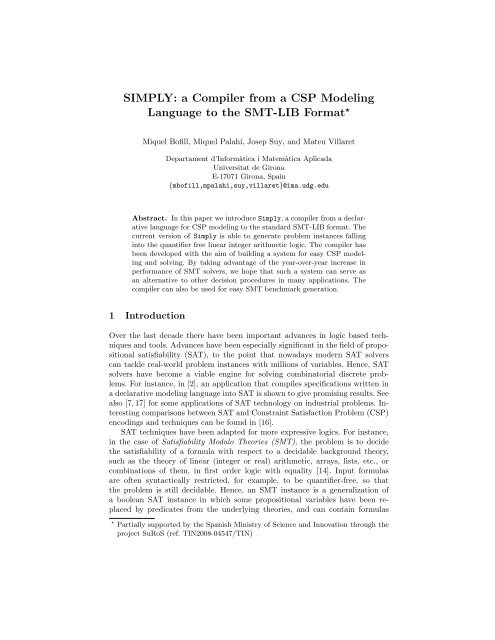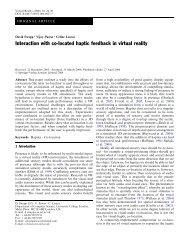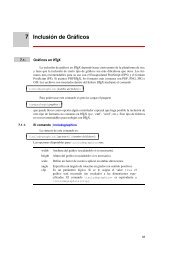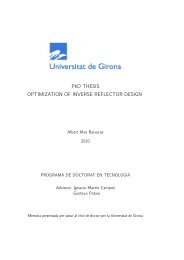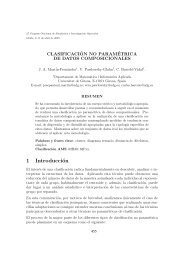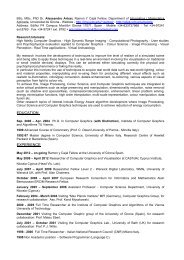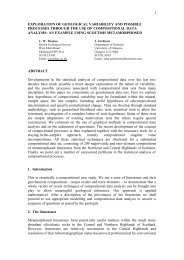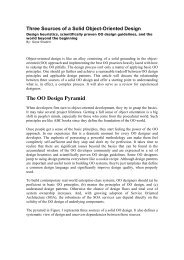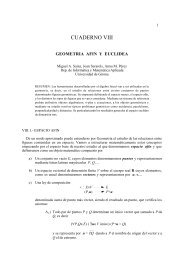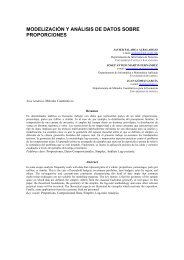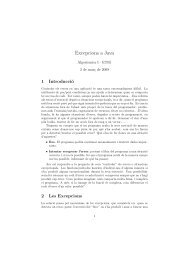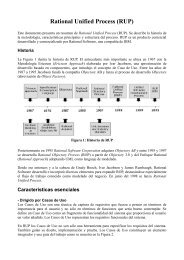SIMPLY: a Compiler from a CSP Modeling Language to the SMT-LIB ...
SIMPLY: a Compiler from a CSP Modeling Language to the SMT-LIB ...
SIMPLY: a Compiler from a CSP Modeling Language to the SMT-LIB ...
You also want an ePaper? Increase the reach of your titles
YUMPU automatically turns print PDFs into web optimized ePapers that Google loves.
like, e.g., f(f(x) − f(y)) ≠ f(z) ∧ x + z ≤ y ∧ y ≤ x ⇒ z < 0, providing a muchricher modeling language than plain propositional formulas. Adaptations of SATtechniques <strong>to</strong> <strong>the</strong> <strong>SMT</strong> framework have been described in [15].The main application area of <strong>SMT</strong> is hardware and software verification.However, <strong>the</strong> available <strong>the</strong>ories do not restrict <strong>the</strong> usage of <strong>SMT</strong> <strong>to</strong> verificationproblems and, in fact, <strong>the</strong>y allow <strong>to</strong> encode many problems outside <strong>the</strong> verificationarea in a very natural way. There are already promising results in <strong>the</strong>direction of adapting <strong>SMT</strong> techniques for solving <strong>CSP</strong>s, even in <strong>the</strong> case of combina<strong>to</strong>rialoptimization (see, e.g., [10] for an application of an <strong>SMT</strong> solver onan optimization problem, being competitive with <strong>the</strong> best weighted <strong>CSP</strong> solverwith its best heuristic on that problem). Fundamental challenges on <strong>SMT</strong> forConstraint Programming (CP) and Optimization are detailed in [11].Since <strong>the</strong> beginning of <strong>CSP</strong> solving, its holy grail has been <strong>to</strong> obtain a declarativelanguage that allows users <strong>to</strong> easily specify <strong>the</strong>ir problem and forget about<strong>the</strong> techniques required <strong>to</strong> solve it. There are a lot of successful systems in thisdirection, just <strong>to</strong> comment on two of <strong>the</strong>m: MiniZinc [9] proposes <strong>to</strong> be a standard<strong>CSP</strong> modeling language that can be translated in<strong>to</strong> a kind of intermediatecode called FlatZinc, for which several solvers provide specialized front-ends;ESSENCE [5] allows <strong>the</strong> user <strong>to</strong> specify combina<strong>to</strong>rial problems in a formal languagewith natural language and discrete ma<strong>the</strong>matics facilities.Simply is intended <strong>to</strong> be a declarative programming system for easy modelingand solving of <strong>CSP</strong>s. Although <strong>the</strong> richness of its input language does not reach<strong>the</strong> level of ESSENCE or MiniZinc, its simplicity makes it really practical. Theinput language of Simply (see Fig. 1) is similar <strong>to</strong> that of EaCL [8] and MiniZinc,and its main implemented features are arrays, Forall sentences, comprehensionlists, and some global constraints.Problem:queens_8Datan:=8;DomainsDom rows=[1..n];VariablesIntVar q[n]::rows;ConstraintsAllDifferent([q[i] | i in [1..n]]);Forall(i in [1..n-1]) {Forall(j in [i+1..n]) {q[i]-q[j]j-i;q[j]-q[i]j-i;}}Fig. 1. queens 8.y: A naive encoding for <strong>the</strong> 8-Queens problem.
Simply works in <strong>the</strong> spirit of SPEC2SAT [3], which transforms problem specificationswritten in NP-SPEC [1] in<strong>to</strong> SAT instances in DIMACS format. However,as said, <strong>the</strong> input language of Simply is similar <strong>to</strong> that of EaCL and, mostimportantly, it generates <strong>SMT</strong> instances according <strong>to</strong> <strong>the</strong> standard <strong>SMT</strong>-<strong>LIB</strong>language [13] instead of SAT instances. Then, <strong>the</strong> problem can be solved by usingany <strong>SMT</strong> solver supporting <strong>the</strong> required <strong>the</strong>ories. Thanks <strong>to</strong> <strong>the</strong> higher levelof expressivity of <strong>SMT</strong>, <strong>the</strong> resulting <strong>SMT</strong> instances are smaller than if <strong>the</strong>ywhere just plain SAT and, in many cases, as we show in Section 4, <strong>the</strong> problemscan be solved in a reasonable amount of time by state-of-<strong>the</strong>-art <strong>SMT</strong> solvers.Our aim is <strong>to</strong> take advantage of <strong>the</strong> race for efficiency between <strong>SMT</strong> solvers,and <strong>to</strong> expand <strong>the</strong> application of <strong>SMT</strong> techniques <strong>to</strong> new areas. The system canalso serve as a <strong>CSP</strong> benchmark genera<strong>to</strong>r for <strong>SMT</strong> solvers comparison. Currently,Simply generates quantifier-free linear integer arithmetic formulas, but <strong>the</strong>re areplans <strong>to</strong> extend <strong>the</strong> compiler in order <strong>to</strong> deal with o<strong>the</strong>r interesting <strong>the</strong>ories suchas, e.g., arrays and bit-vec<strong>to</strong>rs.The rest of <strong>the</strong> paper is structured as follows. In Section 2 we recall somebasic concepts on <strong>SMT</strong>. In Section 3 we introduce <strong>the</strong> <strong>to</strong>ol and its language, andgive some details about <strong>the</strong> compiler. In Section 4 we discuss some benchmarks.Finally, in Section 5 we conclude and discuss fur<strong>the</strong>r work.2 Satisfiability Modulo TheoriesSatisfiability Modulo Theories (<strong>SMT</strong>) is <strong>the</strong> problem of deciding <strong>the</strong> satisfiabilityof a first-order formula with respect <strong>to</strong> some background first-order <strong>the</strong>ory. Thatis, an <strong>SMT</strong> instance is a first-order formula where some function and predicatesymbols have predefined interpretations, according <strong>to</strong> <strong>the</strong> background <strong>the</strong>ories.Examples of <strong>the</strong>ories are Equality and Uninterpreted Functions, Linear IntegerArithmetic, Linear Real Arithmetic, <strong>the</strong>ir fragments Integer Difference Logicand Real Difference Logic, Arrays (useful in modeling and verifying softwareprograms), Bit-Vec<strong>to</strong>rs (useful in modeling and verifying hardware designs), orcombinations of <strong>the</strong>m (see [13] for details). Most <strong>SMT</strong> solvers are restricted <strong>to</strong>decidable quantifier free fragments of <strong>the</strong>ir logics, but this suffices for many applications.Usually, <strong>SMT</strong> solvers deal with problems with thousands of clauseslike, e.g., x + 3 < y ∨ y = f(f(x + 2)) ∨ g(y) ≤ 1, containing a<strong>to</strong>ms over combined<strong>the</strong>ories, and involving functions with no predefined interpretation, i.e.,uninterpreted functions.There are two main approaches <strong>to</strong> solve <strong>SMT</strong> instances, namely, <strong>the</strong> eagerand <strong>the</strong> lazy approach. In <strong>the</strong> eager approach, <strong>the</strong> formula is translated in<strong>to</strong>an equisatisfiable propositional formula. This allows <strong>the</strong> use of off-<strong>the</strong>-shelf SATsolvers, but has important drawbacks like, e.g., exponential memory blow-ups.For this reason most, if not all, state-of-<strong>the</strong>-art <strong>SMT</strong> solvers implement a lazyapproach, which does not involve a translation in<strong>to</strong> SAT. One of <strong>the</strong>se approachesis DPLL(T ) [12], which consists of a general DPLL(X) engine, very similar innature <strong>to</strong> a SAT solver, whose parameter X is instantiated with a specializedsolver Solver Tfor a given <strong>the</strong>ory T , producing a DPLL(T ) system. The basic
idea is making <strong>the</strong> DPLL(X) engine and Solver Twork in cooperation: while<strong>the</strong> DPLL(X) engine is in charge of enumerating (partial) propositional models,Solver Tis responsible for checking whe<strong>the</strong>r <strong>the</strong>se models are consistent with <strong>the</strong>given <strong>the</strong>ory T (for example, if T is <strong>the</strong> <strong>the</strong>ory of Linear Integer Arithmetic and<strong>the</strong> current boolean model contains x + 2y ≤ 0, −y − z ≤ 0 and x − 2z > 1, <strong>the</strong>nSolver Thas <strong>to</strong> detect that <strong>the</strong> current boolean assignment is T -inconsistent).Notice that Solver Tonly needs <strong>to</strong> handle conjunctions of literals <strong>from</strong> <strong>the</strong>ory T .In this way, given a formula F and a <strong>the</strong>ory T , we are determining whe<strong>the</strong>r <strong>the</strong>reis a model of T ∪ {F }.Current <strong>SMT</strong> solvers can deal with several <strong>the</strong>ories and logics. For <strong>the</strong> purposesof our <strong>to</strong>ol, as we explain in Section 3, <strong>the</strong>re are two logics which are especiallyrelevant, namely, quantifier free Integer Linear Arithmetic (QF LIA) andits fragment Integer Difference Logic (QF IDL). QF LIA formulas are booleancombinations of inequations between linear polynomials over integer variables.QF IDL formulas are boolean combinations of inequations of <strong>the</strong> form x − y < bwhere x and y are integer variables and b is an integer constant (see [13] fordetails). Such a<strong>to</strong>ms occur in <strong>the</strong> definition of feasible solutions for many problems.For instance, <strong>the</strong>y can be used <strong>to</strong> express constraints on <strong>the</strong> time elapsedbetween pairs of events. Since <strong>the</strong> satisfiability of conjunctions of difference logicliterals can be reduced <strong>to</strong> <strong>the</strong> absence of negative cycles in finite weighted graphs,it can be decided in O(n 3 ) time by <strong>the</strong> Bellman-Ford algorithm. For this reason,many solvers give a special treatment <strong>to</strong> such kind of literals.3 Simply: The <strong>to</strong>olIn this section we describe <strong>the</strong> input language and features of Simply throughan example. Let us consider <strong>the</strong> n-Queens problem: given a number n of queensof <strong>the</strong> chess game, <strong>the</strong> problem is <strong>to</strong> find a position in a board of size n × n,for each queen, such that no queen threatens any o<strong>the</strong>r (i.e., <strong>the</strong>y are not in <strong>the</strong>same column, row or diagonal). A naive model of <strong>the</strong> n-Queens problem (forn = 8) in <strong>the</strong> Simply input language can be found in Fig. 1, with an array q ofn integer variables where q[i], for i in 1..n, denotes <strong>the</strong> row where <strong>the</strong> queenof column i is placed. The problem is solvable iff <strong>the</strong>re exists an assignment forq, according <strong>to</strong> its domain, such that all <strong>the</strong> posted constraints are satisfied, i.e.,all <strong>the</strong> values of q are different (i.e., no two queens are in <strong>the</strong> same row) and <strong>the</strong>distances between <strong>the</strong> indexes (columns) and values (rows) of any two pair ofelements of <strong>the</strong> array are distinct (i.e., no two queens are in <strong>the</strong> same diagonal).In Fig. 2 <strong>the</strong> architecture of Simply is depicted throughout <strong>the</strong> process ofcompiling and solving <strong>the</strong> 8-Queens problem. Let <strong>the</strong> input of <strong>the</strong> compiler be <strong>the</strong>queens 8.y file of Fig. 1. In <strong>the</strong> compilation process all constants are replaced by<strong>the</strong>ir associated value, and all variables are translated in<strong>to</strong> <strong>SMT</strong> integer variables.Constraining a variable <strong>to</strong> its domain results in a disjunction of equalities when<strong>the</strong> domain is an explicit enumeration of values, or in<strong>to</strong> a conjunction of twoinequality predicates when <strong>the</strong> domain is described as a range. The translationof <strong>the</strong> constraints typically results in<strong>to</strong> a conjunction of QF LIA predicates and,
Fig. 2. The architecture of Simply.in some occasions (as in this case for queens 8.y), in<strong>to</strong> a conjunction of QF IDLpredicates. In <strong>the</strong> end, <strong>the</strong> compilation process produces a queens 8.smt file (seeFig. 3) in <strong>the</strong> standard <strong>SMT</strong>-<strong>LIB</strong> format.The generated <strong>SMT</strong> problem instance can <strong>the</strong>n be solved by any of <strong>the</strong> <strong>SMT</strong>solvers supporting <strong>the</strong> QF LIA logic. Solving queens 8.smt with <strong>the</strong> desired<strong>SMT</strong> solver will result in<strong>to</strong> a sat or unsat answer (notice that <strong>the</strong>se solversare complete). In addition, some of <strong>the</strong>m (e.g., Yices [4]) can return a model(in particular, as shown in Fig. 4, <strong>the</strong> values of <strong>the</strong> <strong>SMT</strong> variables) when <strong>the</strong>problem is satisfiable. In general <strong>the</strong> names of <strong>the</strong> variables are easy <strong>to</strong> interpret.However, we have left as future work <strong>the</strong> recovering process <strong>from</strong> <strong>SMT</strong> solutions<strong>to</strong> values of <strong>the</strong> variables in <strong>the</strong> original (queens 8.y) file, as <strong>the</strong>re is no standardformat for solution output.3.1 Structure of <strong>the</strong> Simply input filesSince we are interested in modeling <strong>CSP</strong>s easily, one of <strong>the</strong> goals of our <strong>to</strong>ol issimplicity. For this reason, we have chosen <strong>the</strong> input language of Simply <strong>to</strong> besimilar <strong>to</strong> that of EaCL [8] and MiniZinc [9]. The syntax of our language, withBNF-style production rules following <strong>the</strong> notation of [13], can be found in <strong>the</strong>extended version of this paper at: http://ima.udg.edu/~villaret/simply.A <strong>CSP</strong> instance specification in our language has four parts:1. Data definition. This is where <strong>the</strong> constants, that will be used in <strong>the</strong> rest of<strong>the</strong> specification, are defined. These can be ei<strong>the</strong>r integer or boolean constantsand <strong>the</strong>ir associated expressions must be evaluable at compilationtime.
(benchmark queens_8.smt:source {Generated by Simpl.y, ima.udg.edu (ESLiP)}:category {testing}:logic QF_IDL:extrafuns ((q_1 Int) ..... (q_8 Int)):formula(and(and(and (>= q_1 1) (= q_8 1) (
3.2 The ConstraintsThe input language deals with formulas, global constraints and <strong>the</strong> If Then Elseconstraint.– Formulas, or boolean expressions, are basic constraints built up <strong>from</strong> integerand boolean variables and constants. The following opera<strong>to</strong>rs are supported:=, , = for integers and Not, And, Or, Xor, Implies and Iff forbooleans.– Currently <strong>the</strong> following global constraints are supported:• Sum(List,Value). This constraint enforces equality between Value and<strong>the</strong> sum of all elements of List. When List is empty, Value is enforced<strong>to</strong> be zero.• Count(List,Value,N). This constraint states equality between N and<strong>the</strong> number of occurrences of Value in List. When List is empty, N isenforced <strong>to</strong> be zero.• AllDifferent(List) requires all <strong>the</strong> elements of List <strong>to</strong> be different.Let us remark that <strong>the</strong> elements of List, as well as <strong>the</strong> Value and N parameters,are allowed <strong>to</strong> be arithmetic expressions containing integer variables.– The If Then Else (φ) {C1} {C2} constraint states that, when <strong>the</strong> formulaφ is satisfied, <strong>the</strong>n <strong>the</strong> constraints C1 must be satisfied and, when φ is notsatisfied, <strong>the</strong>n <strong>the</strong> constraints C2 must be satisfied. Let us remark that <strong>the</strong>formula φ does not need <strong>to</strong> be evaluable at compilation time.Constraints can be posted ei<strong>the</strong>r (i) directly, (ii) through <strong>the</strong> If-Then-Elsestatement (which has nothing <strong>to</strong> do with <strong>the</strong> If Then Else constraint), or (iii)through <strong>the</strong> Forall statement. These two statements are processed at compilationtime. For instance, when <strong>the</strong> compiler finds an If-Then-Else statement, itevaluates <strong>the</strong> If condition. If it is true, <strong>the</strong> constraints of <strong>the</strong> Then branch areposted and, o<strong>the</strong>rwise, <strong>the</strong> constraints of <strong>the</strong> Else branch are posted.It is important <strong>to</strong> notice <strong>the</strong> difference between <strong>the</strong> If-Then-Else statementand <strong>the</strong> If Then Else constraint, whose condition, as said, is not evaluated atcompilation time. Consider, for instance, <strong>the</strong> following example:If (i
This results in<strong>to</strong> <strong>the</strong> replication of <strong>the</strong> constraint m[i]m[i-1] with <strong>the</strong> localvariable i being replaced by <strong>the</strong> appropriate values (<strong>the</strong> compilation techniquesused for <strong>the</strong> expansion are quite similar <strong>to</strong> <strong>the</strong> ones used for comprehension lists):m[2]m[1]; m[3]m[2]; m[4]m[3];Lists can be extensional, by directly enumerating elements and ranges e.g.,[1, x, 3..5, m[a]+3], or intensional via comprehension lists à la Haskell. Thispowerful and expressive feature allows us <strong>to</strong> generate complicated lists easily. Weillustrate its usage with <strong>the</strong> following example:[ m[i,j] | i in [1..3], j in [1..3], ij ]results in<strong>to</strong>[ m[1,2], m[1,3], m[2,1], m[2,3], m[3,1], m[3,2] ]The first part of a comprehension list is <strong>the</strong> pattern, i.e., <strong>the</strong> expressionthat we want <strong>to</strong> generate. Currently, patterns must be arithmetic expressions(in this example, <strong>the</strong> elements of <strong>the</strong> bidimensional array m). The rest of <strong>the</strong>comprehension list is formed by two distinct kinds of expressions, namely, <strong>the</strong>genera<strong>to</strong>rs (in <strong>the</strong> example, i in [1..3] and j in [1..3], that expand <strong>the</strong>pattern) followed by <strong>the</strong> filters, that restrict <strong>the</strong>se expansions (e.g., ij).3.3 CompilationThe compiler has been implemented in Haskell. The compilation process hastwo steps: <strong>the</strong> first step only checks for syntactic compliance and some minorsemantic details, and generates an intermediate code. The second step is <strong>the</strong>one in charge of semantic analysis and <strong>the</strong> final <strong>SMT</strong>-<strong>LIB</strong> code generation. Thiscode generation step distinguishes between expressions that must be evaluatedat compilation time (such as, for instance, <strong>the</strong> expressions in <strong>the</strong> condition of <strong>the</strong>If-Then-Else statement), or translated in<strong>to</strong> <strong>SMT</strong>-<strong>LIB</strong> expressions (for instancea basic constraint).The names of <strong>the</strong> variables are preserved <strong>from</strong> <strong>the</strong> input file <strong>to</strong> <strong>the</strong> resulting<strong>SMT</strong>-<strong>LIB</strong> formula. The only exceptions are arrays: for instance, m[10] istranslated in<strong>to</strong> ten <strong>SMT</strong> variables m 1,m 2,...,m 10.The function in charge of <strong>the</strong> final code generation is codeGeneration, whichreceives an IntermediateCode and returns a String with <strong>the</strong> generated code. Toillustrate <strong>the</strong> simplicity and convenience of using Haskell for <strong>the</strong> code generationstep, in Fig. 5 we show <strong>the</strong> codeGeneration function for <strong>the</strong> intermediate codeof <strong>the</strong> global constraint Count. First of all, <strong>the</strong> function unfolds list and obtains<strong>the</strong> value of value. Then, it generates <strong>the</strong> list of <strong>the</strong> comparisons between <strong>the</strong>elements of <strong>the</strong> unfolded list and <strong>the</strong> value that we are looking for. Next, itapplies <strong>the</strong> ite opera<strong>to</strong>r <strong>to</strong> each element reifying <strong>the</strong>se comparisons 1 . In <strong>the</strong>end, it returns <strong>the</strong> string that enforces <strong>the</strong> value of times <strong>to</strong> be equal <strong>to</strong> <strong>the</strong> sumof <strong>the</strong> reifications.1 Notice that <strong>the</strong> <strong>SMT</strong>-<strong>LIB</strong> ite opera<strong>to</strong>r will return 1 when <strong>the</strong> comparison is satisfiedand 0 o<strong>the</strong>rwise.
codeGeneration :: IntermediateCode -> StringcodeGeneration (COUNT list value times)= codewherel = (unfoldList list)v = (expValue value)comps = map (\x -> "(= "++ x ++" "++ v ++")") lreifi = map (\x -> "(ite "++ x ++" 1 0 )") compssum = "(+ "++ (concat reifi) ++")"code = "(= "++(expValue times)++" "++sum++")"Fig. 5. Haskell code for compiling <strong>the</strong> Count global constraint.4 Examples and BenchmarksIn <strong>the</strong> following we describe <strong>the</strong> decisional <strong>CSP</strong>s used in our benchmarks andillustrate <strong>the</strong> use of Simply for one of <strong>the</strong>m. The problems are <strong>the</strong> following:– <strong>CSP</strong>Lib [6] problem 015, Schur’s Lemma. The problem is <strong>to</strong> put n ballslabelled {1, . . . , n} in<strong>to</strong> 3 boxes so that, for any triple of balls (x, y, z) withx + y = z, not all are in <strong>the</strong> same box. This problem has a solution iffn < 14. In <strong>the</strong> table of Fig. 7, <strong>the</strong> entry Schurl i j denotes <strong>the</strong> instance of<strong>the</strong> problem with i balls and j boxes.– <strong>CSP</strong>Lib problem 030, Balanced Academic Curriculum Problem (BACP). TheBACP objective is <strong>to</strong> design a balanced academic curriculum by assigningperiods <strong>to</strong> courses in a way such that <strong>the</strong> academic load of each period isbalanced, i.e., as similar as possible. The curriculum must obey <strong>the</strong> followingadministrative and academic regulations:1. Courses must be assigned within a maximum number of academic periods(n periods).2. Each course has a number of credits or units that represent <strong>the</strong> academiceffort required <strong>to</strong> successfully follow it (course load[n courses]).3. Some courses can have o<strong>the</strong>r courses as prerequisites.4. A minimum amount of academic credits per period is required <strong>to</strong> considera student as full time, and a maximum amount of academic creditsper period is allowed in order <strong>to</strong> avoid overload (load per period lb,load per period ub).5. A minimum number of courses per period is required <strong>to</strong> consider a studentas full time, and a maximum number of courses per period is allowedin order <strong>to</strong> avoid overload (courses per period lb, courses per periodub).The goal is <strong>to</strong> assign a period <strong>to</strong> every course in a way such that <strong>the</strong>minimum and maximum academic load for each period, <strong>the</strong> minimum andmaximum number of courses for each period, and <strong>the</strong> prerequisite relationshipsare satisfied. In Fig. 6 we can find <strong>the</strong> modeling used in <strong>the</strong>
enchmarks for this problem. Using <strong>the</strong> Count global constraint we restrict<strong>the</strong> number of courses per period. Notice that course per period[t]has domain [courses per period lb .. courses per period lb]. With<strong>the</strong> Forall statement we “load” <strong>the</strong> table of credits per period and with<strong>the</strong> global constraint Sum we restrict <strong>the</strong> number of credits per period. Noticeagain that load per period[t] has domain [load per period lb ..load per period lb]. In <strong>the</strong> table of Fig. 7, <strong>the</strong> entry Bacp 12 j denotes<strong>the</strong> instance of <strong>the</strong> BACP 12 problem with j periods.Problem:bacp_12_6Data n_courses := 66; n_periods := 6;load_per_period_lb := 10; load_per_period_ub := 24;courses_per_period_lb := 2; courses_per_period_ub := 10;DomainsDom periods=[1..n_periods];Dom addload=[load_per_period_lb..load_per_period_ub];Dom addcourses=[courses_per_period_lb..courses_per_period_ub];Dom load=[1..5]; Dom load_ext=[0..5];VariablesIntVar course_load[n_courses]::load;IntVar acourses[n_courses]::periods;IntVar mload[n_courses,n_periods]::load_ext;IntVar load_per_period[n_periods]::addload;IntVar course_per_period[n_periods]::addcourses;Constraints// courses loadcourse_load[1]=1;course_load[2]=3;...// course prerrequisitesacourses[7] < acourses[1];...Forall(t in [1..n_periods]){Count([acourses[j] | j in [1..n_courses]], t, course_per_period[t]);Forall(c in [1..n_courses]) {If_Then_Else( acourses[c] = t ){ mload[c,t] = course_load[c]; }{ mload[c,t] = 0; } ;}Sum( [ mload[i,t] | i in [1..n_courses] ], load_per_period[t] );}Fig. 6. A modeling for <strong>the</strong> BACP 12 problem instance with 6 periods.– Job-shop scheduling. A job shop has some machines, each performing a differen<strong>to</strong>peration. There are some jobs <strong>to</strong> be performed and a job is a sequence
of tasks. Each task involves processing by a single machine for some durationand a machine can operate on at most one task at a time. Tasks cannot beinterrupted. The goal is, given a deadline, <strong>to</strong> schedule each job such thatits ending time does not exceed <strong>the</strong> deadline. In <strong>the</strong> table of Fig. 7, <strong>the</strong>entry Jobshop i means an instance of <strong>the</strong> Job-shop problem with maximalduration i, 5 machines and 8 jobs.– Queens (see Section 3). In <strong>the</strong> table of Fig. 7, <strong>the</strong> entry Queens i means aninstance of <strong>the</strong> queens problem with i queens.We have run <strong>the</strong> <strong>SMT</strong> solvers which participated in <strong>the</strong> QF LIA division of<strong>the</strong> Satisfiability Modulo Theories Competition 2 (<strong>SMT</strong>-COMP) 2008, namely,Z3.2, MathSAT-4.2, CVC3-1.5, Barcelogic 1.3 and Yices 1.0.10, against somebenchmarks generated with Simply <strong>from</strong> <strong>the</strong> previous problems. 3For <strong>the</strong> sake of comparison, we have run some solvers of different natureon <strong>the</strong> same problems, namely, G12 MiniZinc 0.9, ECLiPSe 6.0, SICStus Prolog4.0.7, SPEC2SAT 1.1 and Comet 1.2. The same benchmarks have been usedfor G12 MiniZinc 0.9, ECLiPSe 6.0 and SICStus Prolog 4.0.7 (after a translation<strong>from</strong> <strong>the</strong> MiniZinc modeling language <strong>to</strong> <strong>the</strong> FlatZinc low-level solver inputlanguage, by using <strong>the</strong> MiniZinc-<strong>to</strong>-FlatZinc transla<strong>to</strong>r mzn2fzn). SPEC2SATtransforms problem specifications written in NP-SPEC in<strong>to</strong> SAT instances inDIMACS format, and thus can work in cooperation with any SAT solver supportingthat format. In our tests, we have used SPEC2SAT <strong>to</strong>ge<strong>the</strong>r with zChaff2007.3.12. With respect <strong>to</strong> Comet, only its constraint programming module hasbeen tested. In order for <strong>the</strong> comparison <strong>to</strong> be fair, we have preserved as much aspossible <strong>the</strong> modeling used in <strong>SMT</strong> and avoided <strong>the</strong> use of any search strategywhen dealing with o<strong>the</strong>r solvers, as no search control is possible within <strong>SMT</strong>solvers.Fig. 7 shows <strong>the</strong> time in seconds spent by each solver in each problem, witha timeout of 1800 seconds. The benchmarks were executed on a 3.00 GHz IntelCore 2 Duo machine with 2 Gb of RAM running under GNU/Linux 2.6.The column labeled Simply refers <strong>to</strong> <strong>the</strong> Simply compilation time. The following5 columns contain <strong>the</strong> solving time spent by <strong>the</strong> different <strong>SMT</strong> solvers on<strong>the</strong> generated <strong>SMT</strong> instances. The rest of columns detail <strong>the</strong> times (includingcompilation and solving) spent by solvers of o<strong>the</strong>r nature. We can observe <strong>the</strong>following:– For <strong>the</strong> Queens problem, G12 obtains <strong>the</strong> best results. The poor performanceof <strong>SMT</strong> solvers on this problem is probably due <strong>to</strong> <strong>the</strong> fact that <strong>the</strong>modeling (see Fig. 1) results in a <strong>SMT</strong> instance with only unit clauses, while<strong>SMT</strong> is well-suited for problems whose satisfiability highly depends on <strong>the</strong>combination of <strong>the</strong> boolean structure and <strong>the</strong> background <strong>the</strong>ory.2 <strong>SMT</strong>-COMP: The SAT Modulo Theories Competition (http://www.smtcomp.org).3 Since our naive modeling of <strong>the</strong> Queens problem falls in<strong>to</strong> <strong>the</strong> QF IDL fragmen<strong>to</strong>f QF LIA, we have made this explicit in <strong>the</strong> generated instances. In this way, <strong>the</strong><strong>SMT</strong> solvers with a specialized <strong>the</strong>ory solver for QF IDL can take profit of it.
– For <strong>the</strong> BACP problem, similar results are obtained by <strong>SMT</strong> solvers, G12 andSICStus Prolog. However, complicated instances around <strong>the</strong> phase transitionare not solved by any of <strong>the</strong>m. The <strong>SMT</strong> instances generated by Simplyfor this problem include a relevant boolean structure mixed with arithmeticexpressions, mainly due <strong>to</strong> <strong>the</strong> Count and Sum global constraints (see Fig. 6).This is probably why some <strong>SMT</strong> solvers obtain extremely good results onthis problem. It is also important <strong>to</strong> notice that SPEC2SAT fails <strong>to</strong> solveall <strong>the</strong> instances, since <strong>the</strong> generated SAT formula is <strong>to</strong>o big for zChaff.Moreover, Comet is very unstable on this problem.– For <strong>the</strong> Schur’s Lemma problem, good results are obtained by most of <strong>the</strong>solvers. Surprisingly, G12 consumes all <strong>the</strong> time with no answer. With <strong>the</strong>chosen modeling, Simply is able <strong>to</strong> generate an <strong>SMT</strong> instance with no arithmeticat all, since all expressions can be evaluated at compile time.– For <strong>the</strong> Job-shop problem, best results are obtained by some of <strong>the</strong> <strong>SMT</strong>solvers and by ECLiPSe. This is again a problem with a relevant booleanstructure, and some arithmetic.Globally, it seems that most of <strong>the</strong> <strong>SMT</strong> solvers are good in all <strong>the</strong> problemsconsidered. This is especially relevant if we take in<strong>to</strong> account that those solverscome <strong>from</strong> <strong>the</strong> verification arena and, <strong>the</strong>refore, have not been designed withthose kind of constraint problems in mind. Moreover, <strong>the</strong>y seem <strong>to</strong> scale upvery well with <strong>the</strong> size of <strong>the</strong> problems. Let us remark that <strong>the</strong>se problems arejust <strong>the</strong> first ones at hand that we have considered, i.e., we have not artificiallychosen <strong>the</strong>m. For this reason, <strong>SMT</strong> can be expected <strong>to</strong> provide a nice compromisebetween expressivity and efficiency for solving <strong>CSP</strong>s in some contexts.5 Conclusion and fur<strong>the</strong>r workWe have presented Simply, a <strong>to</strong>ol for easy <strong>CSP</strong> modeling and solving, whosemain novelty is <strong>the</strong> generation of <strong>SMT</strong> problem instances in <strong>the</strong> standard <strong>SMT</strong>-<strong>LIB</strong> format as output. Our aim is <strong>to</strong> take advantage <strong>from</strong> <strong>the</strong> improvementsthat take place <strong>from</strong> year <strong>to</strong> year in <strong>SMT</strong> technology and methods, in order<strong>to</strong> solve <strong>CSP</strong>s. Our <strong>to</strong>ol can also serve as a <strong>CSP</strong> benchmark genera<strong>to</strong>r for <strong>SMT</strong>solvers comparison. However, much work is still <strong>to</strong> be done in <strong>the</strong> development ofSimply <strong>to</strong> make it competitive with o<strong>the</strong>r <strong>to</strong>ols for <strong>CSP</strong> solving. We distinguishamong three aspects:Features of <strong>the</strong> <strong>to</strong>ol Probably <strong>the</strong> most important aspect of future work is <strong>to</strong>study <strong>the</strong> way of obtaining better <strong>SMT</strong> encodings <strong>from</strong> our modeling language.This can be done ei<strong>the</strong>r by obtaining less naive translations of constraints, especiallyfor global ones, and by introducing new <strong>the</strong>ories and logics. For instance,(unidimensional) arrays of integers in Simply programs can be flattened in<strong>to</strong> integervariables (as we currently do) or <strong>the</strong>y can be directly translated in<strong>to</strong> <strong>SMT</strong>array variables. Never<strong>the</strong>less, since <strong>SMT</strong> solvers highly differ in <strong>the</strong> treatmentgiven <strong>to</strong> different <strong>the</strong>ories and logics, more experimentation has <strong>to</strong> be done in
Simply + <strong>SMT</strong> solverO<strong>the</strong>r <strong>to</strong>olsSimply (compilation)Z3.2MathSAT-4.2CVC3-1.5Barcelogic 1.3Queens 50 0.22 t.o. 53.00 m.o. 11.72 29.47 0.22 2.04 6.98 248.01 t.o.Queens 100 0.72 t.o. t.o. m.o. 389.04 19.22 0.84 t.o. 28.51 t.o. t.o.Queens 150 1.54 t.o. t.o. m.o. 995.94 t.o. 150.40 t.o. 256.18 t.o. t.o.Yices 1.0.10G12 MiniZinc 0.9mzn2fzn + ECLiPSe 6.0mzn2fzn + SICStus 4.0.7SPEC2SAT 1.1Comet 1.2Bacp 12 6 0.17 0.55 2.53 t.o. 56.98 0.19 0.84 t.o. 3.8 m.o. 268.56Bacp 12 7 0.18 t.o. t.o. t.o. t.o. t.o. t.o. t.o. t.o. m.o. t.o.Bacp 12 8 0.22 t.o. t.o. t.o. t.o. t.o. t.o. t.o. t.o. m.o. t.o.Bacp 12 9 0.21 0.27 10.86 t.o. 314.91 0.64 0.94 t.o. 5.3 m.o. 0.51Bacp 12 10 0.24 0.24 14.97 t.o. 190.10 0.79 1.44 t.o. 6.02 m.o. 0.60Bacp 12 11 0.24 0.27 13.60 t.o. 237.50 1.24 1.70 t.o. 7.97 m.o. 19.56Bacp 12 12 0.26 0.48 13.24 t.o. 338.46 1.32 40.59 t.o. 11.32 m.o. t.o.Schurl 12 3 0.06 0.01 0.08 7.91 0.03 0.02 t.o. t.o. 0.24 0.38 0.39Schurl 13 3 0.08 0.04 0.07 14.30 0.05 0.05 t.o. t.o. 0.28 0.55 0.40Schurl 14 3 0.09 0.23 0.50 18.24 0.12 0.16 t.o. t.o. 0.32 0.50 0.40Schurl 15 3 0.10 0.35 0.79 29.15 0.15 0.18 t.o. t.o. 0.37 0.73 0.40Jobshop 54 0.31 0.12 0.27 104.97 7.79 2.69 34.13 1.54 33.30 80.41 1.79Jobshop 55 0.32 0.20 0.35 211.48 11.57 3.63 122.16 2.16 t.o. 80.03 11.65Jobshop 56 0.30 0.12 0.46 358.53 12.08 4.37 396.03 3.13 t.o. 88.11 100.01Jobshop 57 0.30 0.34 0.89 475.55 16.05 6.62 1115.09 1.13 t.o. 85.66 892.54Jobshop 58 0.34 0.10 0.25 134.71 20.75 11.48 0.09 1.22 236.64 95.11 0.82Fig. 7. Time in seconds spent on solving <strong>the</strong> problems detailed in Section 4. The firstcolumn refers <strong>to</strong> Simply compilation time. Time out (t.o.) was set <strong>to</strong> 1800 seconds.Memory out is denoted by m.o.order <strong>to</strong> decide a suitable encoding for every construct. From <strong>the</strong> aforementionedexperimentation, we would like Simply <strong>to</strong> be able <strong>to</strong> au<strong>to</strong>matically determine asuitable logic for each problem. Ano<strong>the</strong>r option could be letting <strong>the</strong> user indicate<strong>the</strong> desired target logic. This would make Simply be a more complete benchmarkgenera<strong>to</strong>r.Also, as said in Section 3, we need <strong>to</strong> provide a translation-back module forevery <strong>SMT</strong> solver, in order <strong>to</strong> translate <strong>the</strong> model found (if any) <strong>to</strong> a set of valuesof <strong>the</strong> original Simply program variables. This module will not be unique since
<strong>the</strong>re is no standard language for <strong>SMT</strong> solver solution answers 4 . Never<strong>the</strong>less,<strong>the</strong> definition of a standard language for models of satisfiable benchmarks isplanned in <strong>the</strong> <strong>SMT</strong>-<strong>LIB</strong> definition document [13].The compiler can also be improved in order <strong>to</strong> obtain <strong>SMT</strong> formulas withoutunevaluated subexpressions that could be evaluated at compilation time. Forinstance (+ 3 (+ a 10)) should be (+ a 13).Input language The input language can be extended in several directions. Forexample, input/output operations should be added in order <strong>to</strong>, e.g., be able <strong>to</strong>load a problem instance <strong>from</strong> a file. The language could also be enriched so thatusers can define <strong>the</strong>ir own predicate constraints. Formula opera<strong>to</strong>rs could beextended by allowing lists of formulas as parameters. This would allow comprehensionlists <strong>to</strong> generate formulas <strong>to</strong>o instead of just arithmetic expressions.Concerning <strong>the</strong> declarativeness of <strong>the</strong> language, more global constraints suchas, for instance, cumulative, circuit and element could be added. It could alsobe interesting <strong>to</strong> add set variables and <strong>the</strong>refore <strong>to</strong> provide global constraints on<strong>the</strong>m. We believe that <strong>the</strong> use of <strong>the</strong> bit-vec<strong>to</strong>rs <strong>the</strong>ory for encoding those constraintswould result in compact <strong>SMT</strong> instances that could be solved efficiently.The addition of optimization capabilities <strong>to</strong> Simply heavily depends on havingthose capabilities already implemented in <strong>SMT</strong> solvers. However, optimizationis not <strong>the</strong> main interest of <strong>the</strong> <strong>SMT</strong> community and so it is only supportedby some <strong>SMT</strong> solvers, such as Yices [4]. For <strong>SMT</strong> solvers not having optimizationcapabilities, one possibility could be <strong>to</strong> transform <strong>the</strong> optimization problemin<strong>to</strong> a decision problem by adding <strong>the</strong> objective function as an additional constraint,and <strong>the</strong>n compute <strong>the</strong> optimum with (e.g. linear or binary) search. Thisis roughly what is done in [10] although, in this case, it is done internally by <strong>the</strong>solver. However, doing this <strong>from</strong> outside <strong>the</strong> solver would have <strong>the</strong> drawback ofhaving <strong>to</strong> start <strong>from</strong> scratch at each search.Finally, a complementary and interesting direction of research can be <strong>the</strong>development of a compiler <strong>from</strong> <strong>the</strong> MiniZinc or <strong>the</strong> FlatZinc languages <strong>to</strong> <strong>the</strong><strong>SMT</strong>-<strong>LIB</strong> format, or even <strong>to</strong> <strong>the</strong> native language of some concrete <strong>SMT</strong> solver(in order <strong>to</strong> exploit some particular capabilities of it).Benchmarking We have done some benchmarking between <strong>SMT</strong> solvers andsome solvers of different nature, on a few classic constraint satisfaction problems.In most of <strong>the</strong>m, <strong>the</strong> performance of <strong>the</strong> <strong>SMT</strong> solvers has turned out <strong>to</strong> be similaror even better than of o<strong>the</strong>rs (without strategies). However, additional experimentsneed <strong>to</strong> be done in order <strong>to</strong> know which kind of problems can be solvedin reasonable time by using our <strong>to</strong>ol. For example, less naive formulations (e.g.,with symmetry breaking) of classic problems need <strong>to</strong> be tested. We also plan <strong>to</strong>do some experiments with industrial problems and compare <strong>the</strong> performance ofstate-of-<strong>the</strong>-art <strong>SMT</strong> solvers with o<strong>the</strong>r <strong>CSP</strong> solvers on <strong>the</strong> same problems.Linux and Windows binaries of Simply, as well as documentation and somebenchmarks, can be found at: http://ima.udg.edu/~villaret/simply.4 There exist <strong>SMT</strong> solvers that cannot even be queried for a model.
References1. Marco Cadoli, Giovambattista Ianni, Luigi Palopoli, Andrea Schaerf, andDomenico Vasile. NP-SPEC: an executable specification language for solving allproblems in NP. Computer <strong>Language</strong>s, 26(2–4):165–195, July 2000.2. Marco Cadoli, Toni Mancini, and Fabio Patrizi. SAT as an effective solving technologyfor constraint problems. In Foundations of Intelligent Systems, 16th Intl.Symposium, ISMIS’06, volume 4203 of LNCS, pages 540–549. Springer, 2006.3. Marco Cadoli and Andrea Schaerf. Compiling problem specifications in<strong>to</strong> SAT.Artificial Intelligence, 162(1–2):89–120, 2005.4. B. Dutertre and L. de Moura. The Yices <strong>SMT</strong> solver. Tool paper available athttp://yices.csl.sri.com/<strong>to</strong>ol-paper.pdf, August 2006.5. Alan M. Frisch, Warwick Harvey, Chris Jefferson, Bernadette Martínez-Hernández,and Ian Miguel. Essence: A constraint language for specifying combina<strong>to</strong>rial problems.Constraints, 13(3):268–306, 2008.6. Ian P. Gent and Toby Walsh. <strong>CSP</strong> <strong>LIB</strong>: A benchmark library for constraints. InCP, volume 1713 of LNCS, pages 480–481. Springer, 1999.7. Henry A. Kautz. Deconstructing planning as satisfiability. In Proceedings of<strong>the</strong> Twenty-first Conference on Artificial Intelligence, AAAI’06, pages 1524–1526.AAAI Press, 2006.8. Patrick Mills, Edward Tsang, Richard Williams, John Ford, James Borrett, andWivenhoe Park. Eacl 1.5: An easy constraint optimisation programming language.Technical Report CSM-324, University of Essex, Colchester, U.K., 1999.9. Nicholas Ne<strong>the</strong>rcote, Peter J. Stuckey, Ralph Becket, Sebastian Brand, Gregory J.Duck, and Guido Tack. MiniZinc: Towards a standard CP modelling language.In Principles and Practice of Constraint Programming, 13th International Conference,CP’07, volume 4741 of LNCS, pages 529–543. Springer, 2007.10. R. Nieuwenhuis and A. Oliveras. On SAT Modulo Theories and OptimizationProblems. In Theory and Applications of Satisfiability Testing, 9th InternationalConference, SAT’06, volume 4121 of LNCS, pages 156–169. Springer, 2006.11. Robert Nieuwenhuis, Albert Oliveras, Enric Rodríguez-Carbonell, and Albert Rubio.Challenges in Satisfiability Modulo Theories. In 18th International Conferenceon Rewriting Techniques and Applications, RTA’07, volume 4533 of LNCS, pages2–18. Springer, 2007.12. Robert Nieuwenhuis, Albert Oliveras, and Cesare Tinelli. Solving SAT and SATModulo Theories: From an abstract Davis–Putnam–Logemann–Loveland procedure<strong>to</strong> DPLL(T). Journal of <strong>the</strong> ACM, 53(6):937–977, 2006.13. Silvio Ranise and Cesare Tinelli. The <strong>SMT</strong>-<strong>LIB</strong> Standard: Version 1.2. Technicalreport, Department of Computer Science, The University of Iowa, 2006. Availableat www.<strong>SMT</strong>-<strong>LIB</strong>.org.14. Rober<strong>to</strong> Sebastiani. Lazy satisability modulo <strong>the</strong>ories. Journal on Satisfiability,Boolean <strong>Modeling</strong> and Computation, 3(3-4):141–224, 2007.15. Hossein M. Sheini and Karem A. Sakallah. From propositional satisfiability <strong>to</strong>satisfiability modulo <strong>the</strong>ories. In Theory and Applications of Satisfiability Testing,9th Intl. Conference, SAT’06, volume 4121 of LNCS, pages 1–9. Springer, 2006.16. Toby Walsh. SAT vs <strong>CSP</strong>. In Principles and Practice of Constraint Programming,6th International Conference, CP’00, volume 1894 of LNCS, pages 441–456.Springer, 2000.17. Hantao Zhang, Dapeng Li, and Haiou Shen. A SAT based scheduler for <strong>to</strong>urnamentschedules. In Theory and Applications of Satisfiability Testing, 7th InternationalConference, SAT’04, Online Proceedings, pages 191–196, 2004.


